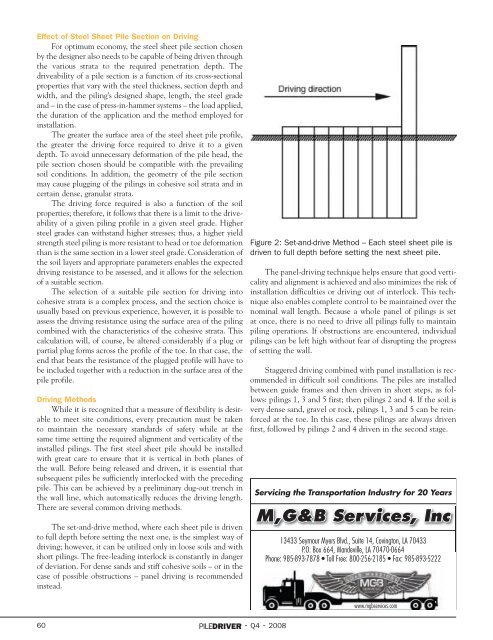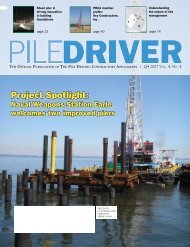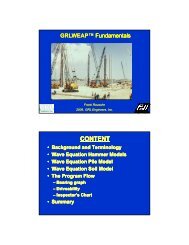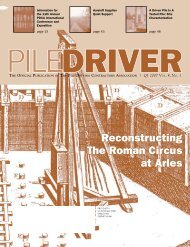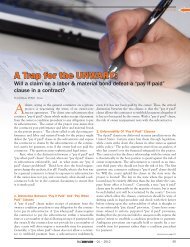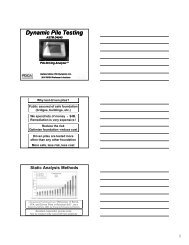Downloads - Pile Driving Contractors Association
Downloads - Pile Driving Contractors Association
Downloads - Pile Driving Contractors Association
You also want an ePaper? Increase the reach of your titles
YUMPU automatically turns print PDFs into web optimized ePapers that Google loves.
Effect of Steel Sheet <strong>Pile</strong> Section on <strong>Driving</strong><br />
For optimum economy, the steel sheet pile section chosen<br />
by the designer also needs to be capable of being driven through<br />
the various strata to the required penetration depth. The<br />
driveability of a pile section is a function of its cross-sectional<br />
properties that vary with the steel thickness, section depth and<br />
width, and the piling’s designed shape, length, the steel grade<br />
and – in the case of press-in-hammer systems – the load applied,<br />
the duration of the application and the method employed for<br />
installation.<br />
The greater the surface area of the steel sheet pile profile,<br />
the greater the driving force required to drive it to a given<br />
depth. To avoid unnecessary deformation of the pile head, the<br />
pile section chosen should be compatible with the prevailing<br />
soil conditions. In addition, the geometry of the pile section<br />
may cause plugging of the pilings in cohesive soil strata and in<br />
certain dense, granular strata.<br />
The driving force required is also a function of the soil<br />
properties; therefore, it follows that there is a limit to the driveability<br />
of a given piling profile in a given steel grade. Higher<br />
steel grades can withstand higher stresses; thus, a higher yield<br />
strength steel piling is more resistant to head or toe deformation<br />
than is the same section in a lower steel grade. Consideration of<br />
the soil layers and appropriate parameters enables the expected<br />
driving resistance to be assessed, and it allows for the selection<br />
of a suitable section.<br />
The selection of a suitable pile section for driving into<br />
cohesive strata is a complex process, and the section choice is<br />
usually based on previous experience, however, it is possible to<br />
assess the driving resistance using the surface area of the piling<br />
combined with the characteristics of the cohesive strata. This<br />
calculation will, of course, be altered considerably if a plug or<br />
partial plug forms across the profile of the toe. In that case, the<br />
end that bears the resistance of the plugged profile will have to<br />
be included together with a reduction in the surface area of the<br />
pile profile.<br />
<strong>Driving</strong> Methods<br />
While it is recognized that a measure of flexibility is desirable<br />
to meet site conditions, every precaution must be taken<br />
to maintain the necessary standards of safety while at the<br />
same time setting the required alignment and verticality of the<br />
installed pilings. The first steel sheet pile should be installed<br />
with great care to ensure that it is vertical in both planes of<br />
the wall. Before being released and driven, it is essential that<br />
subsequent piles be sufficiently interlocked with the preceding<br />
pile. This can be achieved by a preliminary dug-out trench in<br />
the wall line, which automatically reduces the driving length.<br />
There are several common driving methods.<br />
The set-and-drive method, where each sheet pile is driven<br />
to full depth before setting the next one, is the simplest way of<br />
driving; however, it can be utilized only in loose soils and with<br />
short pilings. The free-leading interlock is constantly in danger<br />
of deviation. For dense sands and stiff cohesive soils – or in the<br />
case of possible obstructions – panel driving is recommended<br />
instead.<br />
Figure 2: Set-and-drive Method – Each steel sheet pile is<br />
driven to full depth before setting the next sheet pile.<br />
The panel-driving technique helps ensure that good verticality<br />
and alignment is achieved and also minimizes the risk of<br />
installation difficulties or driving out of interlock. This technique<br />
also enables complete control to be maintained over the<br />
nominal wall length. Because a whole panel of pilings is set<br />
at once, there is no need to drive all pilings fully to maintain<br />
piling operations. If obstructions are encountered, individual<br />
pilings can be left high without fear of disrupting the progress<br />
of setting the wall.<br />
Staggered driving combined with panel installation is recommended<br />
in difficult soil conditions. The piles are installed<br />
between guide frames and then driven in short steps, as follows:<br />
pilings 1, 3 and 5 first; then pilings 2 and 4. If the soil is<br />
very dense sand, gravel or rock, pilings 1, 3 and 5 can be reinforced<br />
at the toe. In this case, these pilings are always driven<br />
first, followed by pilings 2 and 4 driven in the second stage.<br />
Servicing the Transportation Industry for 20 Years<br />
M,G&B Services, Inc<br />
13433 Seymour Myers Blvd., Suite 14, Covington, LA 70433<br />
P.O. Box 664, Mandeville, LA 70470-0664<br />
Phone: 985-893-7878 • Toll Free: 800-256-2185 • Fax: 985-893-5222<br />
www.mgbservices.com<br />
60 • Q4 • 2008


